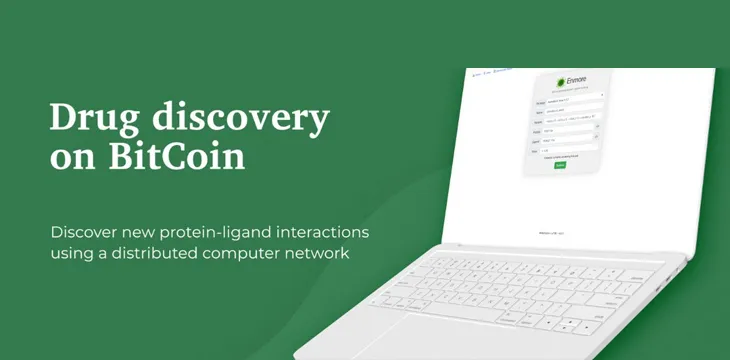|
Getting your Trinity Audio player ready...
|
Using the Bitcoin network for a fee market to engage in research for medical treatments is a great idea. However, it takes someone with a combination of a researcher’s mind and Bitcoin economics to get it started. That’s exactly what Brent Bevear has done with Enmore, creating a proof-of-concept for “an elastic peer market for the computation of protein-ligand interactions.”
Viruses, transmissible diseases and possible treatments are the hottest topic of 2020. The obvious question for non-scientists would be to ask whether Enmore could assist in finding a vaccine or treatment for COVID-19 (or nCoV-2019). The answer is, it’s better as a tool for finding treatments than vaccines, although Enmore, according to Bevear, is “a hammer that could be used for anything.”
https://twitter.com/EnmoreDock/status/1283014824276836353?s=20
For now, it’s aimed at researchers specifically in the field of molecule docking. That’s a process for binding together biologically-relevant molecules, in this case proteins and ligands to see which molecules fit together and which don’t. This is a necessary yet time and resource-intensive process, since only certain combinations work and often need to be found through trial and error.
There are two main ways to find interactions that work. One is to have access to powerful computing resources and perform the task oneself. The other is to find someone else who may have already found the answer you’re looking for. It’s this second problem Enmore is attempting to solve. This aids both academic research and those in the pharmaceutical industries—even those with access to powerful computers can only use them to solve a finite set of solutions at a time.
Enmore interacts with a command-line research program called Autodock Vina, which is used widely in the field. Having discovered a protein-ligand combination that works, researchers can upload it and use Enmore to find if others will pay a price for the information—and if so, how much.
Scientists maybe aren’t the most economics-first group out there. Bevear said as far as he’s aware, no one has tried to establish this kind of fee market for drug research. The tendency has been to look for more crowdsourcing-style collaborations rather than profit. But rather than seek distributed computing for intensive computing power required for the research itself, he turned to monetizing the results instead.
Bitcoin makes this possible with its ability to process automated payments fast and cheap, at any price. Bevear also noted that only by using OP_RETURN (using data capacity removed from BTC but restored in BSV) can be used to store information about the uploaded data, as well as handling the payments side.
Like Codugh, which built a fee market for APIs and other code snippets, Enmore works on the principle that individuals or smaller organizations could benefit by buying and selling small parts of a larger project, using them as leverage to produce bigger ones.
Sydney-based Bevear has also worked on BitPing, the Bitcoin app/service monitor that won the first Bitcoin Association Hackathon (under its old name UptimeSV) in 2019.
CoinGeek spoke to Brent Bevear about Enmore and how it shows another way Bitcoin can advance research merely by applying economic principles to a problem. Read on to find out more.
Brent Bevear, founder, Enmore
Can you tell us a little about your background, both in medical research and Bitcoin?
Sure! I’m a 23-year-old not long graduated student and software developer. Last year, I was fortunate enough to complete a thesis with Sydney’s Garvan Institute of Medical Research where I focused on differential proviral genomics in HIV-1 across different demographics using long read sequencing technology. That was something I was undertaking as I was simultaneously flitting around the world for CoinGeek/BitPing following our success with the first Bitcoin Association hackathon, and was part of my ongoing fascination with viruses and other infectious diseases. Prior to that I completed an Advanced Science degree at the University of Technology Sydney where I majored with a focus on immunology and infectious diseases, looking at virology, proteomics, antibiotic resistance and most relevantly, protein modelling. Outside of that I’ve been a quiet follower of Bitcoin and an autodidact of other various other things.
I’m assuming Enmore is aimed at users who are actually engaged in molecule-docking research, not an attempt to create something like a Bitcoin version of FoldingAtHome (or something for regular people to use). Is that correct?
Mostly correct, anybody who has used AutoDock Vina (which is a particular command line program for seeing what drugs fit into specific proteins) will basically know how to use Enmore, and in that way it is aimed at users who are engaged in molecule docking research, but very much like Bitping it is a two sided market where you have people who need to test these drugs against specific proteins and then the people who actually have the computer to do these. These two groups do not need to share interests.
Just like Bitping, a person running a node couldn’t care less about the uptime of a particular website, but they can sell that information as a profit. The same is true with Enmore, a person with some fast rack computers couldn’t care less about what drug you’re trying to test against what protein, but the person who created that job cares quite a lot. Money brings these parties together.
What is a ligand?
A ligand is just a molecule that binds to another molecule, in this case a drug that binds to an amino acid chain/protein. A little bit of scientific hubris perhaps, but that is what it is referred to as in the literature.
Could this help with development of a vaccine for nCoV-2019 (although it could assist in any kind of drug development research)? Did the current crisis inspire the project, or is it a concept you’ve been working on for a while?
Vaccines and drug therapies are two very different things, and I don’t suspect that Enmore would be particularly valuable to a vaccine researcher (although I could be humbled by that, it is possible to dock proteins against proteins like antibodies to proteins). Enmore is a hammer for anyone to use for anything. Enmore could be used to leverage a distributed computer network to test all non-toxic molecules to get a short list of possible therapeutics that would be useful against a particular nCov-2019 protein to potentially suppress the infection. If you think of Influenza as an analogue, I imagine Enmore is more useful for discovering a new and better Tamiflu (Oseltamivir) which binds to the neuraminidase protein that influenza creates, thus suppressing the infection.
For us non-researchers, what is the current situation like for those in the field? That is, what computing challenges in particular do they face?
For those who are currently doing work like this they currently use private high performance computers (HPCs) which have a pretty significant capital expenditure to acquire. This is true for both academia and private pharmaceutical research. This I think, tends to raise the barrier for entry into drug research higher than it needs to be, and is rather inefficient if you end up acquiring expensive computers for a very narrow field of work. Like all things in a market, there should just be some people selling clothes rather than everyone sewing their own garments. Opening this up to prices and competition will also let independent and precocious researchers to get results quickly rather than trying to attempt to do it themselves on a laptop.
How does forming a fee market for these processes help speed up research?
Instead of everyone having his own high performance computer to do these jobs, we can now have a competitive market for doing this niche computational work, which should hopefully lower prices and make it more accessible to a wider audience of budding researchers.
Also, has anyone ever attempted to establish such a market for this before?
Not that I’m aware of! I know that there have been some naive attempts at using things similar to Folding@Home as a base consensus mechanism for a Bitcoin-style Proof-of-Work, but everything outside of that has mostly been an altruistic/donation model where people would make their often ill-equipped computers available for this kind of number crunching. What I’m trying to do here however is use money to make it a competitive system that people can join and professionalise around, not unlike what we’ve seen with the transition from CPUs to GPUs to ASICs in professionalised server farms in Bitcoin.
Are you using the BSV network to store/process any of the research data/files itself? Or is Enmore just handling the payments side of things?
I’m using the OP_RETURN op code which was part of the original Bitcoin protocol to immutably describe the jobs that researchers want performed and with what parameters. BSV is particularly fit for this purpose because the carrying capacity of that OP_RETURN is now unrestricted in principle following the genesis upgrade and the low fees lend itself towards this kind of work. Beyond that, yes, Bitcoin is just another payment rail for compensating people for their work.
Is there some way we can we help you reach out to your target audience in the field?
I suspect this is a cross I might have to bear on my own unfortunately. I don’t imagine there are more than 5,000 odd people doing this kind of work globally, and even less that know anything about Bitcoin as we understand it in BSV. As I continue to develop the functionality of Enmore I hope to publish it academically so that increasingly more people know about it and can start using it. I’ve got a number of planned additions including GPU support as well as support for other docking packages as well as the various cluster computing packages for Linux. If you’re a drug developer however I’ll happily dock your proteins with my computer if the price is right.

 09-19-2025
09-19-2025 





